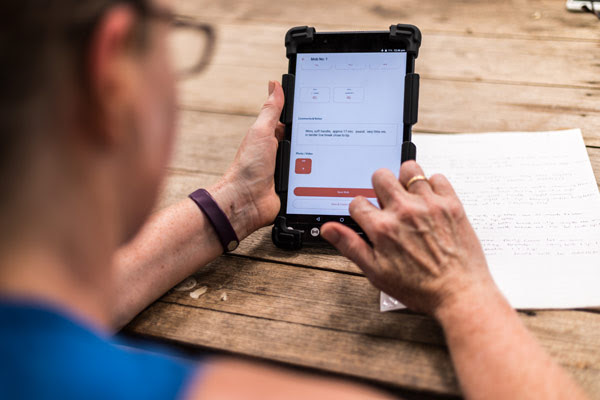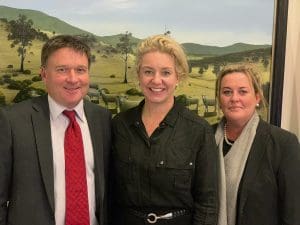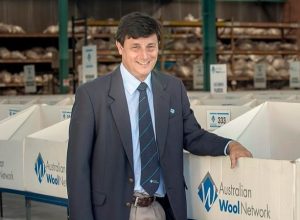
AWI’s defence of its $4.3m outlay on WoolQ has been criticised.
AUSTRALIAN Wool Innovation has mislead senators by claiming its WoolQ platform has addressed market failure in the wool selling system and is an alternative to the auction trade’s Talman system, industry figures believe.
This is despite the industry having online wool selling systems through AuctionsPlus before and during WoolQ’s development and AWI admitting its development of the platform “did not directly target the Talman system risk identified” in its Wool Selling Systems Review.
The industry players have also disputed AWI’s claim that WoolQ – a digital information portal with a recently-added trading capability — “offered an alternative method to the Talman platform for transacting wool.”
The independent Talman system is used in the electronic collation and interchange of wool data for valuation, testing, sale cataloguing and pre-shipment preparation, but was disrupted by a cyber attack in February and March this year.
In its response to questions from Senator Bridget McKenzie of the Rural and Regional Affairs and Transport Committee in March, AWI defended spending $4.3 million on WoolQ by claiming there has been little transformation or modernisation of the wool selling system for more than a century.
“It is expected that addressing this market failure would release unrealised benefits and returns to wool growers through increased competition and returns.
“AWI believed there was significant opportunities to innovate the selling system in line with 21st century technologies and marketing arrangements for the benefit of growers,” the wool industry research, development and marketing body told the Senate committee.
“The (WSSR) review panel concluded that a Wool Exchange Portal (WEP), which became WoolQ, would allow the industry to most efficiently deal with the impediments to development in a holistic manner.
AWI told the senate committee in March this year that although have been no sales to date on the platform, WoolQ was working closely with industry to conduct trials. Since early May, 348 bales have been “transacted” on WoolQ Market. WoolQ and AuctionsPlus began offering online auctions to Australian brokers after the COVID-19 pandemic restrictions forced new social distancing rules for indoor open cry auctions.
The Talman services were restored independent of AWI or WoolQ involvement and the industry is now again using this system and the AWTA electronic data interchange network to transact wool offered through the open cry auction system.
“Importantly, WoolQ offers more than selling options to wool growers, it is a tool for digital collection and storage of all wool grower data.
“The data once collected will then provide the basis for a suite of analytical tools that will assist the wool growers to make more nuanced decisions regarding the selling of their wool, to more timely information the wool and the ability to profile their business,” AWI said.
“Finally, WoolQ will provide the technology to allow traceability and provenance stories to be delivered to customers in an efficient and cost-effective format.”
Click here to read an AWI release about WoolQ Market’s first limited transactional trial online auction on 17 April, 2020.
Significant developments in wool selling in past 50 years
Executive director of the Australian Council of Wool Exporters and Processors, and the Private Treaty Wool Merchants of Australia, Dr Peter Morgan, also refuted AWI’s claim that “there has been little transformation or modernisation of the wool selling system for more than a century.”
“So what about the introduction of sale-by-sample and of pre-sale testing in 1972 and the measurement of staple length and strength in the mid-1980s?”
He said there was also the progressive introduction of sale-by-separation of the “bale from the sale” from the second half of the 1970’s which facilitated:
– The progressive centralisation of selling centres from 14 to 3 between the mid-70’s and the mid-90’s;
– The ability for wool to be stored, lotted and sampled in storage centres that are remote from the selling centres, and;
– The early and progressive introduction of electronic data interchange across all sectors of the industry from 1978.
Dr Morgan said all these developments have contributed to:
– Significant cost savings and productivity gains across the industry both in Australia and internationally, and;
– The availability of objective measurement data to all industry participants along the wool industry pipeline, once again within Australia and internationally.
Confusion as to what WoolQ is – WoolProducers

WoolProducers Australia president Ed Storey, left with then Minister for Agriculture Bridget McKenzie, centre, and WPA CEO Jo Hall last year.
However, WoolProducers Australia chief executive officer Jo Hall said when WoolQ was officially launched in early 2018, two years after the release of the Wool Selling Systems Review report, the wool market was experiencing a great run on prices with the benchmark AWEX Eastern Market Indicator sitting around the 1800-cent mark.
“It is therefore very hard to claim that there was any market failure.
“In fact, the whole time that WoolQ was in development following the release of the WSSR report, the industry was in what was widely regarded as a ‘super cycle’,”she said.
“Given that there was little understanding of what WoolQ was and little support from other sectors of the supply chain it’s hard to understand how WoolQ evolved and who was actually asking for its development.”
Ms Hall said AWI in its response to the Senate Estimates Questions on Notice stated that WoolQ offered an alternative method to the Talman platform.
“However, it is also stated in the response, that after the expenditure of $4.3 million of growers money and two years after it was launched that not one bale of wool had been sold on this platform.
“This seems to be at odds with claims made by the AWI chair, Colette Garnsey, who in a letter to wool growers on 30 March this year stated:
“It has always been WoolQ’s aim to complement all the strengths of the existing system at the same time as delivering additional services, rather than a replacement.”
“If this is the case, this raises serious concerns that WoolQ was developed in competition with private investment for wool selling platforms such as AuctionsPlus,” Ms Hall said.
“This was always a concern of WoolProducers, that the development of WoolQ would deter the private sector investment in the wool industry, due to this investment being put in competition with a compulsory levy funded organisation.”
“It is little wonder that there is confusion as to what WoolQ actually is.”
Senator Bridget McKenzie asked what AWI had done to mitigate the “significant risk” the Talman system posed its levy payers. AWI responded by stating its Wool Selling Systems Review (WSSR) report in 2016 described Talman as “antiquated and inflexible” and that some exporters expressed concerns about the quality of Talman’s services and the time taken to respond to requests for change.
“The Talman risk was one of many identified issues in the WSSR.
“After a year engaging with industry, the WSSR Panel prioritised the build of an industry focused digital information portal (WoolQ) as a tool to promote transparency and choice and the competitiveness of the wool industry, this did not directly target the Talman System risk identified,” AWI said.
“The WSSR identified the risk to industry in the hope that those businesses directly affected (ie. those whose businesses that relied on the service and who had a direct contractual relationship with Talman) would look to take some steps to mitigate those risks.
“In the same way, the WSSR panel felt that 100 percent reliance on an open cry method of trading was a risk to the industry and looked to deliver a solution and still it was not taken up or accepted by the brokers and exporters who directly engage with that selling system,” AWI said.
AWI told the senators that WoolQ platform delivered a suite of digital tools to wool growers, including the eSpeci and use the platform required an annual subscription, although the AWI board has waived the annual subscription for the first two years of the platform’s operation in recognition that wool grower levies helped pay for its development.
“The second is the WoolQ Market whose clients will be the selling agents.
“WoolQ offers an alternative method to the Talman platform for transacting wool,” AWI said.
WoolQ not an alternative to Talman – Colley

AWN managing director John Colley.
However, AWN managing director John Colley said the Talman system and WoolQ were “totally different.”
“WoolQ has been built as a trading platform while the Talman system is a logistics and marketing program and a sales system.
“WoolQ has so many missing parts to it, it is dysfunctional for a broker or an exporter to use it only.”
Mr Colley said AWN has supported and transacted wool on the WoolQ platform.
“But it does none of the functions required in the first stage to get the wool from the grower’s wool store through to a saleable format, which is what Talman does – that’s the electronic data interchange.
“The reality is with the Talman system we go from an eSpeci that we produce, which produces a sale catalogue, which produces information on wool that can be sold,” he said.
He said there are so many parts of the wool trading chain that are missing in WoolQ that “you couldn’t even contemplate replacing the Talman system with what has been presented to us as WoolQ.”
Mr Colley said he recalled AWI chief executive Stuart McCullough stating that WoolQ would not be a trading platform at an International Wool Textile Organisation meeting in Sydney in 2016.
“Yet here we are today where it’s a trading platform, but it’s nothing else; it provides no logistic answers for anybody along the chain.”
Mr Colley said there was no ‘market failure’ when WoolQ was developed as AuctionsPlus was already conducting online selling, although differing definitions for the term were held by the commercial wool trade and researchers.
“There was no market failure, this is something that they (AWI) fabricated in their own mind.
“There has been plenty of digital improvements made between wool brokering and the client, or the exporter and the grower,” he said.
“The only thing that hasn’t changed is the two hours face-to-face interchange of selling, which has still proven to be the quickest way to well wool.
“WoolQ as a selling system does not meet buyer requirements, because they don’t want to look at a lot of lots (simultaneously) on a page,” Mr Colley said.
“They want to be able to buy a lot and then know they’ve secured it, because that allows them to work out how many more bales at what price they need to fill their container.”
Senators need to talk to the wool trade

Wool exporter Josh Lamb at a wool conference in China.
Wool exporter Josh Lamb said exporters flagged Talman as an issue with AWI prior to the WSSR review “only for them to turn around after the WSSR review and tell us that it was an issue.”
He said there was potential for Wool Exchange Portal to make a difference as an information portal for growers before it was called WoolQ.
“It was going in the right direction, but it has morphed into an online training platform, which hasn’t provided much benefit to anyone really.”
He said there is a need for a back-up system to the outdated Talman platform and AWI has spent $4.3 million on WoolQ “on something we already had.”
He said there hasn’t been a market failure in wool selling in Australia up to the recent COVID-19 pandemic.
“We haven’t had a market failure in the last 10 years that I can see – it has been the best 10 years for the industry in 30 years.”
Mr Lamb said Talman was a service provider with a computer system that facilitates the movement of wool between brokers, exporters and shipping agents through the auction system and overseas.
“So it is not accurate to say the WoolQ is an alternative platform to Talman – they are not really the same thing — because Talman does not actually sell wool, all it does is provide the software to move all the electronic data around and use the catalogue – and WoolQ is certainly not that.
“Talman is not there to transact wool, it provides the software to do it, but the transaction of wool is between brokers, exporters and the auction system.”
He said AWI’s statement that ‘WoolQ offers an alternative method to the Talman platform for transacting wool,’ was “100 percent misleading because they are two completely different things”.
“We can’t use WoolQ to pull all our data down from brokers every week to generate our auction catalogues then go in and put our contracts up that we sell wool to, fill those contracts with electronic data and transmit it to a dump and have it shipped overseas – we can’t do that with WoolQ and that’s what we do with Talman.”
Mr Lamb disputed that there had been any market failure in electronic selling with AuctionsPlus supplying an online offer board and more recently (as on WoolQ) a helmsman auction system with simultaneous lot bidding.
Mr Lamb said the senators need to talk to other people in the Australian wool trade about these issues, including brokers and exporters.
“The market is a lot lower now since WoolQ was invented to prevent any market failures and I know they are not related.
“It sounds like the government is taking AWI’s word on everything they ask,” he said.
“How can AWI claim responsibility for the wool market for the last 10 years and then turn around and say that they have had to produce something to stop a market failure?” he asked.
“Because that is what they’ve done and yes, they are responsible for some of it (price rises), there’s no doubt about it,’ he said.
“But you can’t claim responsibility for something good and then turn around and then say it has failed, which is it?”
Mr Lamb said AuctionsPlus has been around for at least 15 years, with its offer board and auction platforms.
“AuctionsPlus did run regular online sales about 5-6 years ago, but it died a slow death because growers didn’t support it and exporters didn’t necessarily support it.
“A similar system has been around 15 years (AuctionsPlus) and they have replicated that system, but haven’t actually brought anything new to the table to what we already had.”
He said the Australian wool auction system was one of the first to go to an electronic data interchange system in 1984. This followed the AWTA starting the transfer of catalogue information by magnetic tape in 1978. These developments were undertaken with non-AWI industry funding.
“The only thing that hasn’t changed is an auctioneer physically dropping the hammer, everything else has evolved to an electronic platform.”
Mr Lamb said the open cry auction system is still more efficient than any of the online systems for selling wool.
“The reason we haven’t migrated to an online platform is because they cannot replicate the efficiencies of the auction room in clearing wool.
“We can sell up to 300 lots an hour in the sale room and no-one has been able to come near that with an online platform.”
He said the online AuctionsPlus and WoolQ auctions were able to sell about 130 lots per hour. Open cry auctions held on the online Zoom teleconferencing recently sold about 250 lots per hour.

Critical point Don Hamblin. Your plan has real merit. Yes, whilst AWI goes on and on about promotion and marketing, it is the on-farm research effort that is neglected. It should all be about research; nothing else. The market is well able to attend to the remainder. What is needed is an industry forum, away from the influence of AWI. There Don Hamblin, Jim Gordon and other like-minded people can plan and then build a groundswell for change. Then we can ask Littleproud to act, and I will be surprised if he doesn’t.
Peter Small, I agree with you 100 percent. There is an army of early processors, brands and retailers out there that understand promotion and marketing to the nth degree. They don’t need help from us. What they do need is a better product that is closer to 100pc “fit for purpose”.
On-farm research is critical, and education and unbiased research on projects we do need. Yes, an industry forum is a great idea. Thank you to Don Hamblin, another very clear thinker.
Jim Gordon is correct — “the only way forward is to give the levy payer a choice.”
We need the whole research and development system to be deregulated like the superannuation system is now; where the industry funds compete against other superannuation funds for wage earners’ funds.
Once a levy rate has been voted on by growers, the grower should be able to invest their levy with any registered research organisation of their choice.
That AWI spends 60 percent of its levy receipts on promotion is an issue for levy payers to consider when making their R&D investment decision.
Once again we have to thank Terry Sim for shining a light into the dark corners of AWI activities. Jim Gordon is correct; the only solution to this AWI anachronism — that blossomed from the decision of the 1937 London Imperial Wool Conference to impose a statutory tax on wool production — is to dump the tax.
Jim Gordon calls on Minister David Littleproud to act. Littleproud is no fool, he cannot act without a groundswell of grower support. We don’t want Littleproud to commit hara-kiri. There is little enough talent in the Morrison Government already.
I first witnessed this wool charade in the autumn of 1964 when that brilliant duo Gunn and Vines did their big sell of the Woolmark symbol. With hard-earned growers levy funds running out their ears, our statutory wool bodies have become very good, in fact expert, at promotion. Promotion that is into fooling wool growers to fund their ill-considered exploits. Then we had the Reserve Price Plan. Need we say any more.
But explicit in our statutory wool bodies’ modus operandi is embedded a sanctimonious culture; they know everything there is to be known about wool promotion. Strong demand for wool is the result of their success, while a weak market … is always the fault of the selling system.
Thus we had, following some weakness in the market in 2014, the Wool Selling Systems Review. And the cover up of expenditure that followed in establishing the Wool Portal, now revealed before the Senate Rural and Regional Affairs and Transport committee.
Senator Bridget McKenzie has again shown her mettle as a warrior in the interests of our industry interests, freed as she now is from the contortions of the government’s sports rorts affair.
Minister Littleproud, please have a read of this wonderful article. The government and the levy payers are financing this fiasco. Another $4.3 million that didn’t need to be spent. Leave it to the private sector. How much longer have we got to put up with this? The sooner AWI is wound up the better. Just have a look at Rugby Australia, $22 million spent on administration and $3 million spent on the players.
The self-interest and politics in AWI is unfixable. The only way forward is to give the levy payer a choice as to who they pay their levies too. Give the power back to the levy payer.
I fully agree Jim Gordon. Many feel that the wool levy model has now reached maturity, with AWI failing time and time again to serve growers’ best interests. Either zero levy vote at WoolPoll or merge AWI with MLA to streamline research and development?
The problem with the physical auction, and to a lesser degree the antiquated Talman systems is the high cost of entry for new buyers in the market. Physical auctions benefit the current players. Imagine a young commodities trader flush with investment bank cash sitting at the Yennora wool centre. No. Open cry might be fast, but if you want more competition, selling models will need to play online, even its a Zoom auction.
The answer to the problem has always been simple in my view; make a bale of wool traceable from farm-to-garment electronically and online. That’s what I tried to do.